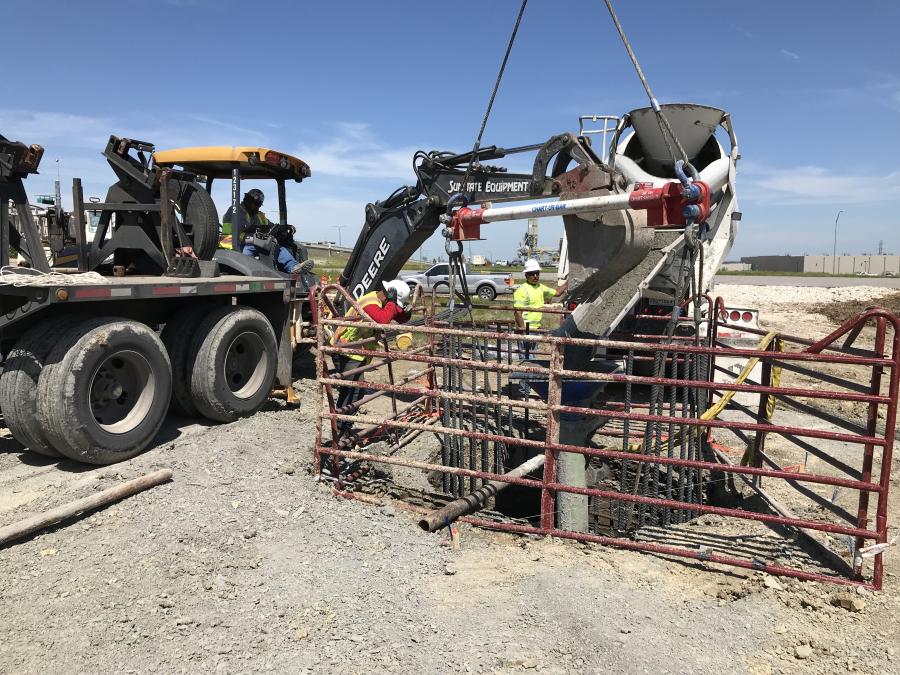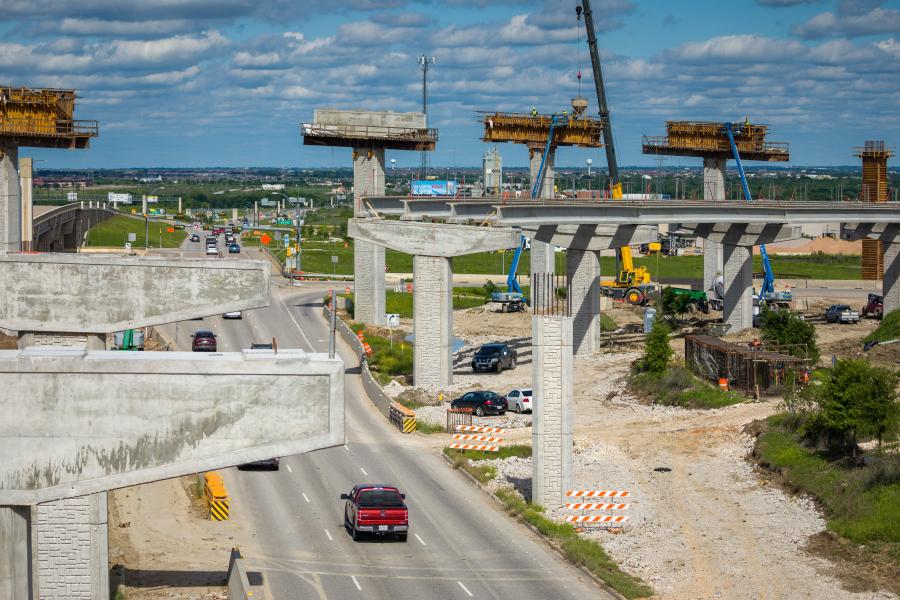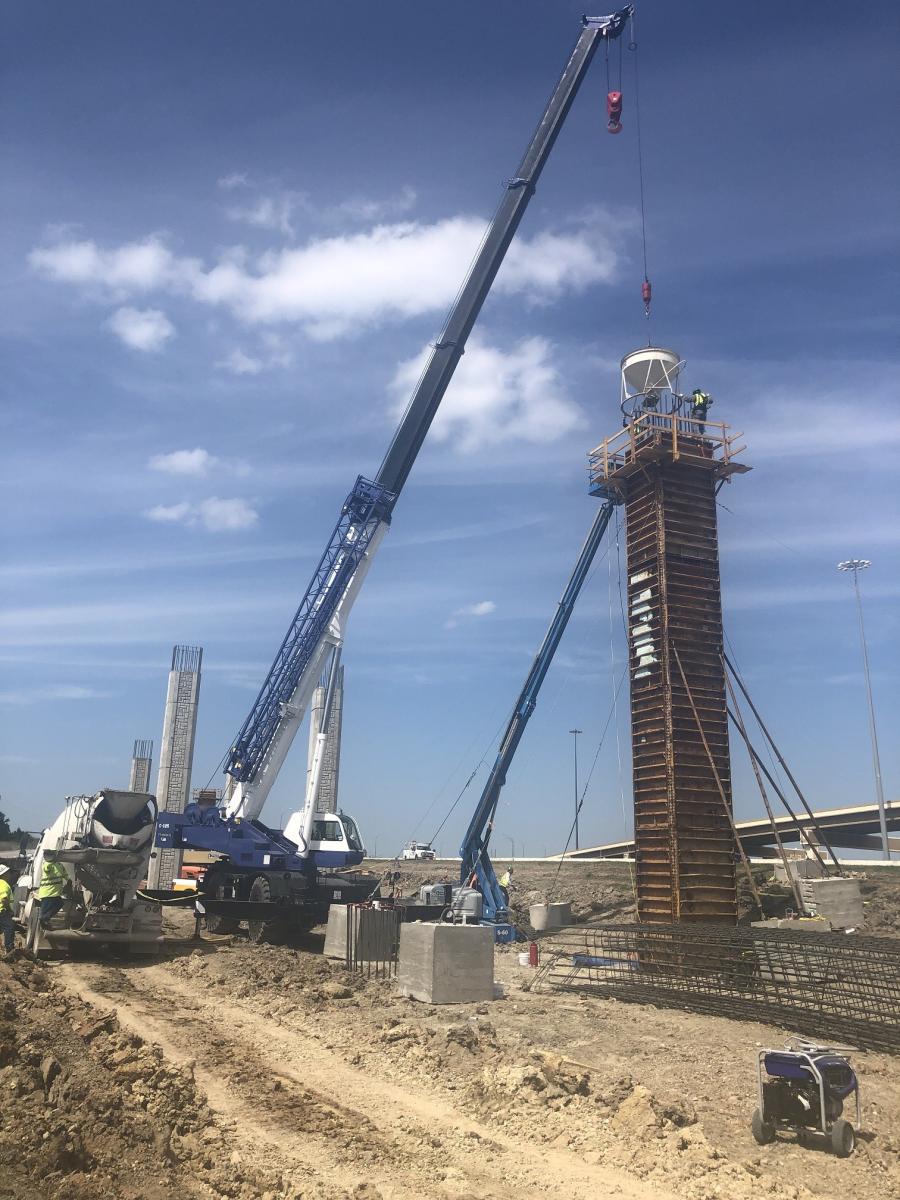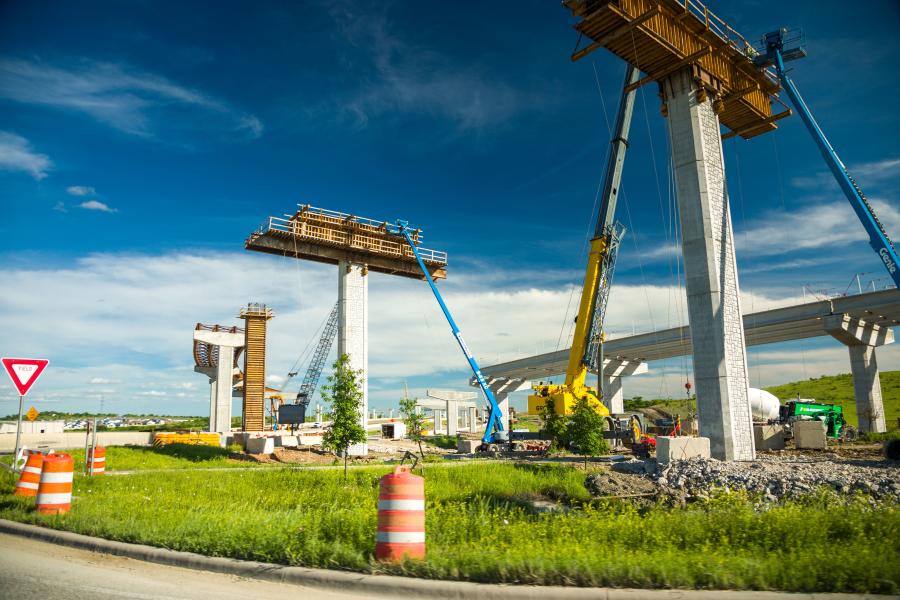Webber LLC, TxDOT and Central Texas Regional Mobility Authority are working to deliver the final flyover of the 290/130 Flyovers Project in east Austin. Crews worked on the first two flyovers of the project shown here.
The partnership of Webber LLC, the Texas Department of Transportation and the Central Texas Regional Mobility Authority has made considerable progress on the Central Texas Regional Mobility Authority 290/130 Flyovers Project in east Austin, as the second of three flyover bridges under construction, at the 290 Toll/SH130 intersection, opened to traffic on July 11.
The 290/130 Flyovers Project is on track for full project completion in 2021, and also includes construction of a non-tolled flyover connecting eastbound 290 Toll to southbound SH 130.
Construction Process
"Webber has been working at an excellent pace throughout the course of the project," said Lloyd Chance, senior project manager—construction for the Mobility Authority. "As they've worked swiftly to capture the incentives, they've also prioritized quality, and it shows in the delivery of their work."
Chance explained the construction process for the flyovers.
"The first step is to remove the grass and topsoil," he said. "The next steps are to drill the shafts, construct columns and caps, place beams, form and pour the bridge decks, form and pour concrete rails, construct bridge approaches and retaining walls and sign and stripe the bridges. This project does not have any major excavation work or clearing of right-of-way, because it is primarily a bridge job."
Lessons learned on the first two flyovers are being applied to the final one.
"We're always looking for lessons learned and best practices to apply for future projects," said Justin Word, the Mobility Authority's director of engineering. "Early on in this project, we determined that major traffic switches would be better undertaken on weekends when closure timeframes are longer and there are lower traffic volumes to manage."
The Mobililty Authority and TxDOT have worked harmoniously.
"We are very proud of the collaborative partnership with TxDOT that has enabled this project to be successfully implemented concurrently with their three-lane widening project on SH 130," said Chance. "While adjacent projects can sometimes pose coordination challenges, our teams have worked cohesively to ensure that each project is a success."
Equipment & Material
Crews are utilizing a Manitowoc 11000-1 crawler crane and a Kobelco CK1600G2 crawler crane to help with putting the formwork together, setting the forms, installing the reinforcing cages, placing concrete using a bucket, setting concrete beams, setting concrete panels and moving/transporting material to the bridge decks. Construction crews also are using a Link-Belt 8050 and a Manitowoc RT 890E; and lifts: Genie 65s, S-85 XCs and S-60V and JLG 460SJs.
The cranes are helping with putting the formwork together, setting the forms, installing the reinforcing cages, placing concrete using a bucket, setting concrete beams, setting concrete panels and moving/transporting material to the bridge decks.
Excavation operations will result in the removal of 45,000 cu. yds. of earth and rock and via demolition and 18,000 sq. yds. of concrete.
New materials being brought in include 11,000 linear ft. of drill shafts, 18,000 cu. yds. of concrete structures, 60,000 linear ft. of concrete beams, 66,500 sq. ft. of MSE retaining wall, 97,000 cu. yds. of embankment, and 594,000 sq. ft/ of bridge deck.
Work is moving along at a rapid pace on the final flyover and the CMTA Railroad Bridge. A couple of exit and entrance ramps, the westbound frontage road for U.S. 290, illumination and Intelligent Transportation System (ITS), overhead sign bridges along U.S. 290, and concrete sealing on all bridge structures remain to be finished.
Project Challenges
Tim Burhop, Webber's project manager, is pleased with the progress, but there have been challenges, as well.
"Overall, construction of the first two flyovers was smooth and efficient," he said. "But each project comes with its own set of challenges. In this case, our crews were actively constructing all three flyovers at once, requiring diligent traffic control coordination. We also drilled and poured several large bridge bent foundations measuring more than 90 inches in diameter. Throughout this project, we've incorporated templates for the monolithic drill shafts to assist with their alignment during drilling and pouring. We've also prioritized finishing during CRCP placements to ensure ride quality requirements are met, since some of the early placements required grinding to achieve the IRI/ride quality requirements.
"Safety is always a concern on the job site, particularly working near live traffic and in elevated work areas," he added. "Our crews are diligent about wearing safety harnesses, using spotters for overhead materials and performing work behind concrete barriers and under lane closures."
"Nighttime operations are particularly busy on the project," said Chance. "To capture the incentives and avoid the mid-day Texas heat, Webber has chosen to perform much of their work at night, such as beam setting, setting/stripping overhangs, tying reinforcing steel, setting precast bridge panels, forming/stripping column/cap forms and deck placements for structures adjacent to live traffic."
Construction of all three flyovers overlapped, but there was an increased focus on one at a time as Webber worked to reach milestones.
"Since the project remains within the existing right-of-way, utilities and water have not presented challenges," said Word. "However, we discovered some isolated soil issues during construction of the approaches and landings of the flyovers. The clay-like material held water and was pumped when proof rolling was performed prior to placement of the proposed embankment material."
The drilled shafts for the East to South flyover started in April 2019, columns started in October, and the bent caps in December.
The Mobility Authority noted that all of the drilled shafts, columns and bent caps are complete; all concrete beams have been installed; and 10 out of the 25 bridge deck spans have been built.
Regarding putting together form work for the columns and bent caps and tying reinforcing steel cages for columns and bent caps, large and tall structures such as columns 8 by 5 ft. and 9 by 6 ft. were used. Various types of bent caps such as inverted T, hammer heads, straddle caps and post tension straddle caps, also were utilized. The structures also are considered mass placement, which requires temperature monitoring.
"We've engaged in detailed coordination with TxDOT's SH 130 widening project in order to effectively tie in to southbound SH 130 just north of Blue Bluff where our projects meet," said Chance.
All Hands on Deck
Burhop has an experienced team assisting him.
"We have a very strong team dynamic," he said. "Each member brings unique skills, experience, and perspective to offer when making collective decisions. We have established great communication, respect and trust for one another, resulting in a very positive and productive work environment. Every member has a clear understanding of their roles and responsibilities, which enables us to successfully work as a team to achieve our common goal."
The concrete is being provided by Texas Concrete.
The project was designed by CP&Y. The cloud-based construction management tool – e-Builder – is being used to coordinate submittals and processing of construction submittals, RFIs, notices of design change and invoicing.
"e-builder has been an effective construction management tool for document control, and workflow processing, including submittals, shop drawings, and other items," said Word.
Automatic portable smart traffic monitoring system to assists with work zone traffic control, increased safety and provides timely updates to drivers is being used. This includes PCMS placed on all four main directional approaches to the project, and non-intrusive speed detectors at regular one-half to one-mile intervals approaching the work zone.
"The PCMS automatically provides real-time messaging to drivers, alerting them of traffic conditions and distances to potentially slowed or stopped vehicles ahead," said Chance.
Peak days have seen 120 Webber and subcontractor employees on-site for the south to west flyover, 150 for the south to west flyover and 132 for east to south flyover. The major subcontractors are Beaird Drilling for drilled shafts; Indus Road & Bridge for concrete structures, Texas Highway Walls for MSE walls, The Levy Company for electrical, ITS, and large overhead signs; Roadway Specialties for MBGF, crash cushions and small signs; Bradco; Kyros; Flasher for striping; and Texas Materials for riprap and mowstrip (flat work). HDR is providing all construction, engineering and inspection services.
Equipment-wise, Webber also is employing dozers, excavators, loaders, drill rigs, rollers, pavers and skytracks.
Main wear and tear issues include hydraulic leaks, incidental dents, cooling issues and friction on parts (e.g. bucket teeth), with most items repaired within 24 hours. Webber has a mechanic that visits daily, but is not dedicated to the project. The keys for maintenance on a project like this are timeliness of reporting issues and not letting routine maintenance turn into serious problems.
Most of Webber's equipment is either owned or leased. It rents equipment from ASCO Equipment, RDO Equipment Co., United Rentals and Hunter Heavy Equipment Inc.
"The project team doesn't deal with vendors directly in relation to equipment," said Burhop. "We have a separate department within Webber that coordinate equipment vendors."
Incentivizing Construction
The incentives are available for the contractor for early completion of the South to West and North to West direct connectors. Webber may earn $8,000 for each working day of early substantial completion of the South to West flyover, up to a maximum of 170 days, and $5,000 for each working day of early substantial completion of the North to West flyover, up to a maximum of 100 days.

"The early completion incentives the Mobility Authority built into the contract really made a difference," said Word. "The North to West and South to West flyovers were completed months ahead of schedule, and if conditions remain as they are, we expect the third and final flyover to be complete later this year/early next year — months ahead of the June 2021 contractual obligation. Incentives have been a valuable contract tool to provide contractors the ability to be rewarded for extraordinary performance. We have seen positive results from incorporation of incentive regimes, allowing our projects to be completed more quickly, with shorter duration of construction impacts to the traveling public."
The South to West direct connector (first) was completed and open to tolling 8 months early, and the North to West direct connector (second) was completed and open to tolling 4 months early.
"Cost savings are translated to real dollars in the form of early toll revenue receipts and reduced months of owner-funded project oversight," said Word. "The traveling public also realizes the benefits of early completion through travel time savings and reduced impacts of the disruptions that come along with an active construction zone."
The Mobility Authority and TxDOT partnership is very satisfied with the quality of Webber's work.
Community Impact
"As we see drivers returning to the roadways, it's more important than ever that we continue to deliver forward-thinking and reliable mobility solutions," said Bobby Jenkins, chairman of the Mobility Authority board of directors. "These connections help lay the foundation for economic recovery as we continue the fight against the COVID-19 pandemic. As part of our commitment to improving the reliability, safety, and connectivity of our region, the Mobility Authority is proud to deliver this second flyover, a symbol of forward progress in these difficult times."
The Mobility Authority, created in 2002 to improve the regional transportation system in Travis and Williamson counties, noted that in early June, toll transactions on the 290 Toll Road indicated a 38.6 percent increase in average weekday traffic since the region's stay-at-home orders went into effect.
"Completion of these flyovers will help eliminate queueing of vehicles off the southbound and northbound main lanes of SH 130," said Word, "and are anticipated to shift approximately 67 percent of vehicles off the southbound SH 130 frontage road and onto the new flyover ramps to westbound 290 Toll." CEG
Irwin Rapoport
A journalist who started his career at a weekly community newspaper, Irwin Rapoport has written about construction and architecture for more than 15 years, as well as a variety of other subjects, such as recycling, environmental issues, business supply chains, property development, pulp and paper, agriculture, solar power and energy, and education. Getting the story right and illustrating the hard work and professionalism that goes into completing road, bridge, and building projects is important to him. A key element of his construction articles is to provide readers with an opportunity to see how general contractors and departments of transportation complete their projects and address challenges so that lessons learned can be shared with a wider audience.
Rapoport has a BA in History and a Minor in Political Science from Concordia University. His hobbies include hiking, birding, cycling, reading, going to concerts and plays, hanging out with friends and family, and architecture. He is keen to one day write an MA thesis on military and economic planning by the Great Powers prior to the start of the First World War.
Read more from Irwin Rapoport here.
Today's top stories






















